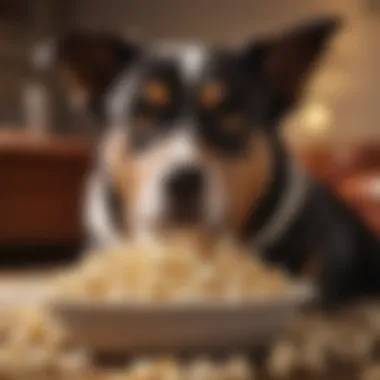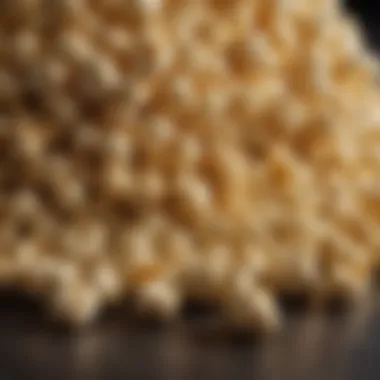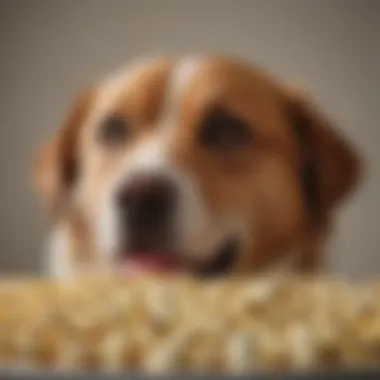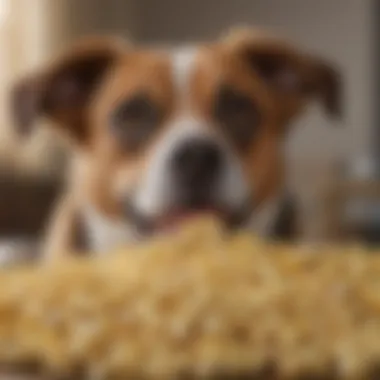Can Dogs Safely Eat Popcorn? A Comprehensive Guide


Intro
This article explores whether dogs can eat popcorn safely. Understanding what foods are appropriate for dogs is essential for their health and well-being. While popcorn may seem like a harmless snack, it is vital to delve into its nutritional content, potential risks, and proper feeding guidelines. This thorough examination aims to provide dog owners with clear insights into the implications of including popcorn in their pets' diets.
Fascinating Facts About the Animal
Unique Characteristics
Dogs have a remarkable ability to digest a variety of foods. Their evolutionary history shows adaptability in their diet. This flexibility allows them to consume foods that are not typically part of a carnivorous diet. However, not all human foods are safe or beneficial for dogs. Understanding these unique traits helps owners make informed dietary choices for their pets.
Extraordinary Abilities
Dogs often exhibit an extraordinary sense of taste and smell. This sensitivity can influence their preferences for certain foods. Some dogs may enjoy the taste of popcorn, prompting owners to consider offering it as a treat. However, it is essential to assess whether this snack provides any nutritional benefits or health risks.
Nutritional Aspects of Popcorn
Popcorn is composed mainly of carbohydrates. It is low in calories when prepared without excess oil or seasoning. Plain, air-popped popcorn can be a source of fiber. However, this does not mean it is a staple for a dog’s diet. While it is a whole grain, the nutritional profile must be evaluated in the context of a balanced diet for dogs.
Potential Health Risks
Dogs may face health risks when consuming popcorn. These risks can include:
- Choking Hazards: Unpopped kernels can pose a choking risk.
- Digestive Issues: Some dogs may experience stomach upset from popcorn.
- Additives and Seasoning: Butter, salt, and other seasonings can harm dogs.
It is crucial for dog owners to be aware of these risks before deciding to share popcorn with their pets.
Guidelines for Responsible Feeding Practices
If a dog owner chooses to feed their pet popcorn, follow these guidelines:
- Moderation is Key: Offer popcorn as an occasional treat only.
- Plain and Air-Popped: Ensure popcorn is free from added butter or salt.
- Observe Reaction: Monitor for any adverse reactions after consumption.
By following these guidelines, owners can safely introduce popcorn into their dog's diet without unnecessary risks.
The American Kennel Club advises that any new food introduced into a dog's diet should be done gradually and in moderation to assess tolerance.
Ending
While popcorn can be a fun treat for dogs in moderation, it is essential to approach feeding it with caution. By understanding the nutritional aspects and potential health risks, dog owners can make informed decisions. Always prioritize a balanced diet tailored to each dog's needs.
Foreword
In the realm of canine nutrition, the question of whether dogs can safely consume popcorn holds significant relevance. Pet owners often seek to understand not only what their furry companions should eat but also the implications of incorporating human snacks into their diets. Food choices for dogs extend beyond mere sustenance; they encompass considerations of health, nutrition, and enjoyment.
Popcorn, a popular snack for humans, presents an interesting case. While many may assume it's safe for dogs, an examination reveals nuances that warrant attention. Understanding these aspects is essential for dog owners aiming to maintain a balanced diet for their pets.
This article aims to dissect the nutritional profile of popcorn while evaluating potential benefits and risks associated with feeding it to dogs. By providing in-depth analysis, we seek to inform pet owners, veterinarians, and those interested in canine nutrition. This careful exploration aims to guide responsible feeding practices, ensuring that canine dietary habits are both safe and beneficial.
Key points for discussion include:


- Nutritional aspects of popcorn
- Health benefits and risks
- Safe consumption guidelines
- Alternative snack options for dogs
Understanding these elements can help foster a healthier relationship between dogs and their food choices.
Understanding Canine Diet
Understanding canine diet is fundamental for pet owners who seek to make informed nutritional decisions for their dogs. It involves recognizing the essential nutrients required by dogs to promote overall health, growth, and longevity. Proper nutrition directly influences a dog's energy levels, behavior, and even its longevity. A nuanced understanding helps in avoiding common pitfalls associated with poor dietary choices.
Dogs are omnivores with specific dietary needs. Their nutritional requirements include proteins, fats, carbohydrates, vitamins, and minerals. Each component plays a distinct role in maintaining health. For example, proteins are crucial for muscle development, while fats are needed for energy and absorption of fat-soluble vitamins. Carbohydrates can provide energy but must be balanced with other nutrients.
In this article, the understanding of canine diets will set the foundation for discussing food choices like popcorn. It is important to consider how any food fits into the broader dietary framework. Dog owners must assess not only the immediate benefits but also the potential long-term implications on their dog’s health.
Nutritional Requirements of Dogs
Nutritional requirements for dogs vary based on factors such as age, size, and activity level. Generally, a balanced diet should consist of:
- Proteins: Critical for growth and repair of tissues. Sources such as chicken, beef, or fish are excellent.
- Fats: Provide essential fatty acids and energy. Sources include fish oil, chicken fat, or flaxseed.
- Carbohydrates: Offer nutritional energy. Brown rice and sweet potatoes are beneficial options.
- Vitamins and Minerals: Play a role in many bodily functions. A dog's diet should include vegetables and fruits for adequate micronutrients.
Dogs’ bodies are designed to metabolize these nutrients efficiently. However, the specific requirements can differ greatly. Puppies require more protein and calories compared to adult dogs. Similarly, senior dogs may benefit from lower calorie diets that include joint-supporting nutrients.
An unbalanced diet can lead to health issues, including obesity, dental problems, and other chronic diseases. Therefore, understanding individual needs is the first step in ensuring optimal pet nutrition.
Role of Treats in Dog Nutrition
Treats can be an essential aspect of dog nutrition when used appropriately. They can serve multiple purposes, including:
- Training Rewards: Treats often facilitate the training process, making learning new commands or tricks easier and more enjoyable for dogs.
- Bonding Opportunities: Feeding treats can enhance the relationship between a dog and its owner.
- Nutritional Supplements: Certain treats can provide additional nutrients that might be lacking in the main diet.
However, it's crucial to consider the quality and quantity of treats. They should not exceed 10% of a dog's daily caloric intake. Excess calories from treats can lead to overweight conditions, impacting the dog's overall health negatively.
Additionally, not all treats are healthy options. Diet choices should focus on natural ingredients free from harmful additives. Care must be taken when selecting treats to ensure they align with a dog’s specific dietary needs and health conditions.
In summary, understanding canine nutrition provides the necessary framework for evaluating foods like popcorn. When chosen wisely, treats can positively impact a dog's life, contributing to training, health, and emotional well-being.
Popcorn as a Snack
Popcorn serves as a widely popular snack for many people, but when it comes to dogs, the implications of this treat require careful consideration. Understanding how popcorn fits into a dog's diet is important for dog owners who seek to maintain their pet's health while also providing them with safe and enjoyable snacks. Given that dogs and humans have different dietary needs and digestive systems, it's crucial to evaluate the specific properties of popcorn and its potential impact on canine health.
What is Popcorn?
Popcorn is a type of corn kernel that expands and puffs up when heated. It is a whole grain, which means it contains the bran, germ, and endosperm, making it a source of carbohydrates and fiber. The kernels are typically used in various formats, from unbuttered to flavored varieties often seen in movie theaters. While popcorn may seem like a harmless, light snack for humans, its nutritional properties and how they translate to canine health must be carefully examined.
Interestingly, popcorn is low in calories and fat when prepared without excessive butter or oil. This quality can make it an attractive option for those looking to offer a crunchy treat. However, how popcorn is prepared can greatly influence its suitability for dogs. For example, popcorn seasoned with salt or other flavorings may introduce unwanted ingredients that are not healthy for dogs.
Nutritional Profile of Popcorn
The nutritional profile of popcorn showcases its primary components:
- Calories: Popcorn is low in calories compared to other snack foods. Unbuttered, air-popped popcorn contains about 30 calories per cup.
- Carbohydrates: This snack primarily consists of carbohydrates, providing quick energy for dogs during active playtime.
- Fiber: Popcorn contains a moderate amount of fiber, which can help maintain healthy digestion in dogs when fed in appropriate amounts.
- Vitamins and Minerals: Though not a significant source of vitamins and minerals, popcorn does offer beneficial nutrients like magnesium and phosphorus.


It is essential to keep in mind that while popcorn has some nutritional benefits, it should not replace a balanced diet meant for dogs. Moderation is key to ensuring that treating your dog to a bit of popcorn does not lead to unintended health consequences.
Important Note: Always consider the method of preparation and the ingredients added to popcorn before sharing it with your dog. Plain, unsalted, and air-popped popcorn is the safest option.
Health Considerations
Understanding the health aspects of feeding popcorn to dogs is vitally important. Not all foods are suitable for canine diets, and it's essential that dog owners consider both the potential benefits and risks associated with any human food. Popcorn, while seemingly harmless, can have implications for a dog's health that deserve careful examination. This section aims to explore these facets in detail, allowing for informed decisions.
Potential Benefits of Popcorn for Dogs
Popcorn may offer some nutritional advantages when provided in moderation. It's a whole grain that, when prepared correctly, has low calories and can be a pleasant treat for dogs. The key benefits to consider include:
- Low Caloric Snack: Popcorn can satisfy cravings without high-calorie intake, making it a better option compared to many commercially prepared dog treats.
- Source of Fiber: It contains fiber which can assist with digestion, possibly contributing to overall gastrointestinal health.
However, these benefits must be weighed against the ability of dogs to properly digest and process popcorn.
Risks of Feeding Popcorn to Dogs
While there are potential benefits to offering popcorn, several risks accompany this snack. Understanding these risks is essential for maintaining a dog's health. It’s crucial to ensure that popcorn is a safe addition to a dog's diet.
Risk of Choking
Choking is a severe concern when it comes to adding popcorn to a dog's diet. The light, airy structure of popped corn can be deceptive. Dogs, especially those who eat quickly, may gulp it down without chewing adequately.
- Key Characteristic: The size and shape of popcorn can easily get lodged in a dog’s throat or windpipe.
- Why It Matters: This risk emphasizes the need for vigilant supervision when giving any snack, especially light foods such as popcorn.
Dental Issues
Dental problems can arise from feeding popcorn to dogs. The crunchy texture can lead to both positive and negative effects on a dog’s dental health.
- Key Characteristic: While the act of chewing can help clean teeth, unpopped kernels may cause splintering or damage to teeth.
- Why It Matters: Monitoring the type of popcorn offered is essential to mitigate these risks, as well as trying to avoid unpopped kernels.
Allergic Reactions
Some dogs may also experience allergic reactions when consuming popcorn. Such responses can be severe and varying in their manifestations.
- Key Characteristic: Symptoms may range from mild itching to serious gastrointestinal disturbances.
- Why It Matters: Understanding the risk of allergies is important. Gradual introduction and observation are wise first steps to ensure a dog does not develop a negative reaction to this snack.
As with any addition to a dog's diet, it's essential to proceed with caution and consult a veterinarian if uncertain.
How to Safely Feed Popcorn to Dogs
Feeding dogs popcorn can be a fun experience, but ensuring safety is paramount. This section covers essential practices and considerations for dog owners who wish to include popcorn in their pets' diets. Following specific guidelines can help minimize risks and enhance the experience, making it beneficial rather than harmful. This includes selecting the right type of popcorn, controlling portions, and being vigilant for any adverse reactions.
Choosing the Right Type of Popcorn
Not all popcorn is created equal when it comes to canine consumption. It is critical to choose plain, air-popped popcorn without any additives. Avoid flavored varieties, especially those containing butter, salt, or artificial seasonings. These can lead to digestive issues or other health complications in dogs.
Consider organic popcorn as well. This option often lacks harmful pesticides found in non-organic varieties. Popcorn prepared without oil or seasoning is ideal, as it reduces calorie intake and lowers the risk of inducing digestive upset.


Portion Control
Portion control is vital when introducing popcorn into a dog's diet. Dogs are generally smaller than humans, so what might be a reasonable snack for a person could be excessive for a dog. A few popped kernels can make an adequate treat, depending on the size of the dog. It is advisable to limit the amount of popcorn to less than ten percent of their daily caloric intake. This balance helps in providing enjoyment without compromising nutritional needs.
A practical approach is to start with a small quantity and observe how your dog reacts. If they seem to enjoy it and show no adverse effects, you can gradually increase the portion size while still being cautious.
Monitoring for Adverse Reactions
After offering popcorn to your dog, closely monitor for any signs of negative reactions. Dogs may experience some form of discomfort or allergies, just like humans. Common symptoms to watch for include vomiting, diarrhea, or unusual behavior. If any of these symptoms occur, it is crucial to consult a veterinarian.
Developing a habit of checking in on your dog after they consume popcorn can greatly assist in recognizing potential issues early. Keep a record of popcorn consumption, noting the amount and any responses. This can be an invaluable tool for discussions with your vet, helping tailor food choices that suit your dog’s specific dietary needs.
Always prioritize your dog's health over the novelty of introducing a new snack. Quality and safety should never be overlooked.
Alternatives to Popcorn for Dogs
In exploring the topic of canine nutrition, it is essential to consider alternatives to popcorn for dogs. While popcorn may have a few benefits, other snack options often provide better nutrition, taste, and safety. As dog owners look to diversify their pets' diets, understanding available alternatives can lead to healthier choices. This section will delve into various healthy snack options and homemade dog treats, encouraging a well-rounded approach to canine nutrition.
Healthy Snack Options
Several nutritious snacks can serve as alternatives to popcorn. Items rich in vitamins, minerals, and healthy fats contribute positively to a dog's overall health. Here are a few options:
- Carrots: Crunchy and low-calorie, they can help clean teeth and are a great source of Vitamin A.
- Sweet Potatoes: A natural source of fiber and essential vitamins, sweet potatoes can be cooked and mashed for a tasty treat.
- Apples: When sliced and the seeds are removed, apples provide Vitamin C and are high in fiber.
- Peanut Butter: Look for unsweetened and unsalted varieties, as they can be a great source of protein and healthy fats but should be given in moderation.
- Green Beans: Low in calories and high in fiber, these can be a chewy snack dogs often enjoy.
Each of these snacks has specific health benefits while also appealing to dogs' natural love of different textures and flavors. Therefore, dog owners should consider incorporating them into their pets' diets.
Homemade Dog Treats
Making homemade dog treats can be a rewarding experience. Not only does it allow owners to control ingredient quality, but it also offers the chance to cater to their dog's preferences. Basic recipes can include nutritional ingredients, which might be lacking in processed snacks. Here are a few ideas:
- Peanut Butter Biscuits: Combining whole wheat flour, peanut butter, and eggs, these biscuits are easy to make and often a favorite among dogs.
- Pumpkin Treats: Using canned pumpkin (not pumpkin pie filling) with oats and eggs makes for a nutritious snack rich in fiber.
- Chicken and Rice Bites: Cooked chicken mixed with rice and flour can create tasty, protein-packed snacks.
- Banana Oatmeal Cookies: Mashed bananas mixed with oats can form a sweet and healthy treat.
Always remember to check ingredients for any potential allergens before you prepare treats.
Homemade dog treats can be a delightful way to show love, ensuring that the dog's diet is both healthy and enjoyable. By diversifying snack options with both healthy commercial choices and homemade recipes, owners can enhance their pet's overall enjoyment of food while also maintaining a suitable dietary regime.
Closure
Understanding that not all treats, including popcorn, are suitable for dogs is crucial. Being mindful of the types of snacks offered can help maintain a well-balanced diet. While popcorn can be an occasional treat, it is essential to adhere to moderation. Too much popcorn may lead to possible health complications such as gastrointestinal distress or weight gain.
One significant point highlighted is the importance of monitoring dogs for any adverse reactions when introducing new foods. Every dog is unique, and what works for one may not work for another. Therefore, keen observance of their behavior after consuming popcorn is advisable.
Furthermore, knowing alternatives to popcorn allows pet owners to diversify their dog's treat options responsibly. Healthy snacks can provide various nutritional benefits that popcorn may lack. Homemade treats can also be an excellent way to ensure a dog's diet is both nutritious and satisfying.
Ultimately, this article serves as a comprehensive resource for dog owners. By understanding the implications of feeding popcorn to dogs, they can make informed decisions that uphold the health and wellbeing of their pets.
Importance of Additional Resources
- Reliable Information: Additional resources ensure that dog owners access accurate and up-to-date information. Improper feeding practices can lead to health issues, so reliable knowledge is paramount.
- Diverse Perspectives: Various articles, studies, and expert opinions provide a broader view of canine nutrition. This diversity helps in weighing different aspects before deciding on pet food options, like popcorn.
- Practical Guidelines: Resources often offer practical feeding guidelines tailored to various dog breeds and sizes. This information is critical, especially when navigating unconventional snacks such as popcorn.
Valuable Additional Resources
When seeking information on dog nutrition, consider checking the following platforms:
- Wikipedia has summaries on topics like dog diet and nutrition.
- Britannica offers encyclopedia entries that cover canine dietary requirements.
- Online communities, such as discussions on Reddit, provide real-life experiences and opinions from other dog owners.
- Facebook groups are also available where members share advice, tips, and relevant articles regarding pet care.
To provide your dog with a balanced diet and prevent health risks, leveraging these additional resources is encouraged. The amalgamation of expert knowledge, community insights, and reliable information stands as a pillar for responsible pet ownership.







